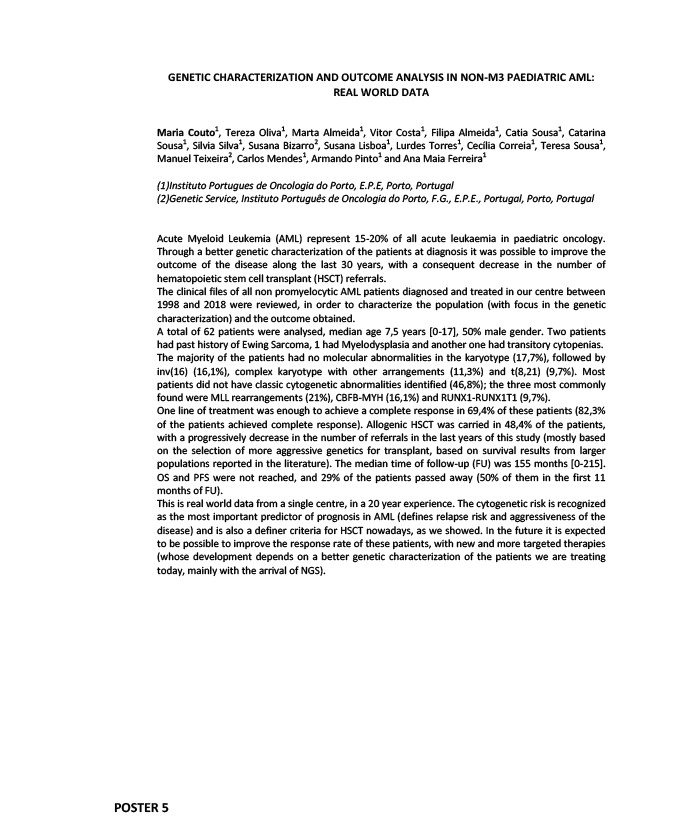
GENETIC CHARACTERIZATION AND OUTCOME ANALYSIS IN NON-M3 PAEDIATRIC AML:
POSTER 5
REAL WORLD DATA
Maria Couto1, Tereza Oliva1, Marta Almeida1, Vitor Costa1, Filipa Almeida1, Catia Sousa1, Catarina
Sousa1, Silvia Silva1, Susana Bizarro2, Susana Lisboa1, Lurdes Torres1, Cecília Correia1, Teresa Sousa1,
Manuel Teixeira2, Carlos Mendes1, Armando Pinto1 and Ana Maia Ferreira1
(1)Instituto Portugues de Oncologia do Porto, E.P.E, Porto, Portugal
(2)Genetic Service, Instituto Português de Oncologia do Porto, F.G., E.P.E., Portugal, Porto, Portugal
Acute Myeloid Leukemia (AML) represent 15-20% of all acute leukaemia in paediatric oncology.
Through a better genetic characterization of the patients at diagnosis it was possible to improve the
outcome of the disease along the last 30 years, with a consequent decrease in the number of
hematopoietic stem cell transplant (HSCT) referrals.
The clinical files of all non promyelocytic AML patients diagnosed and treated in our centre between
1998 and 2018 were reviewed, in order to characterize the population (with focus in the genetic
characterization) and the outcome obtained.
A total of 62 patients were analysed, median age 7,5 years 0-17, 50% male gender. Two patients
had past history of Ewing Sarcoma, 1 had Myelodysplasia and another one had transitory cytopenias.
The majority of the patients had no molecular abnormalities in the karyotype (17,7%), followed by
inv(16) (16,1%), complex karyotype with other arrangements (11,3%) and t(8,21) (9,7%). Most
patients did not have classic cytogenetic abnormalities identified (46,8%); the three most commonly
found were MLL rearrangements (21%), CBFB-MYH (16,1%) and RUNX1-RUNX1T1 (9,7%).
One line of treatment was enough to achieve a complete response in 69,4% of these patients (82,3%
of the patients achieved complete response). Allogenic HSCT was carried in 48,4% of the patients,
with a progressively decrease in the number of referrals in the last years of this study (mostly based
on the selection of more aggressive genetics for transplant, based on survival results from larger
populations reported in the literature). The median time of follow-up (FU) was 155 months 0-215.
OS and PFS were not reached, and 29% of the patients passed away (50% of them in the first 11
months of FU).
This is real world data from a single centre, in a 20 year experience. The cytogenetic risk is recognized
as the most important predictor of prognosis in AML (defines relapse risk and aggressiveness of the
disease) and is also a definer criteria for HSCT nowadays, as we showed. In the future it is expected
to be possible to improve the response rate of these patients, with new and more targeted therapies
(whose development depends on a better genetic characterization of the patients we are treating
today, mainly with the arrival of NGS).